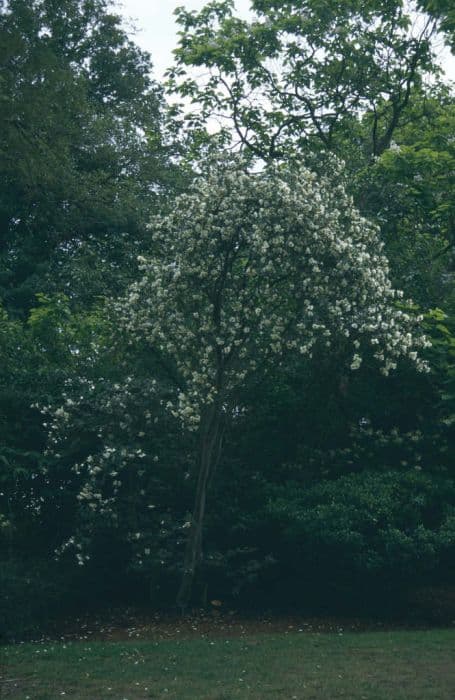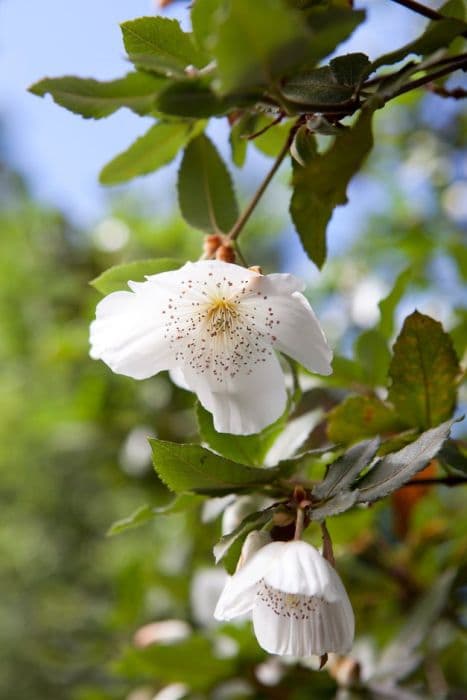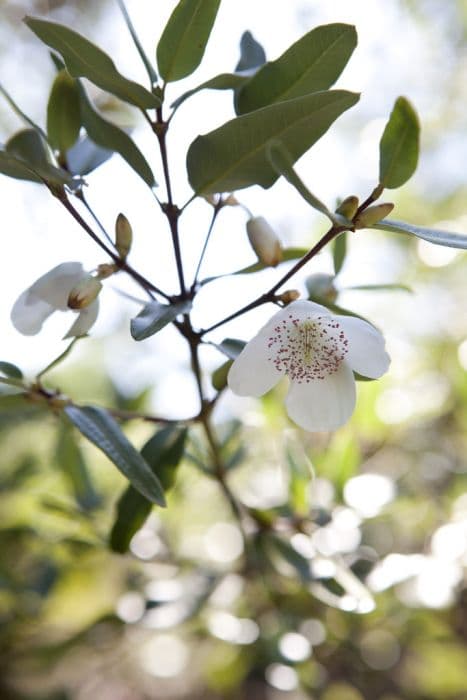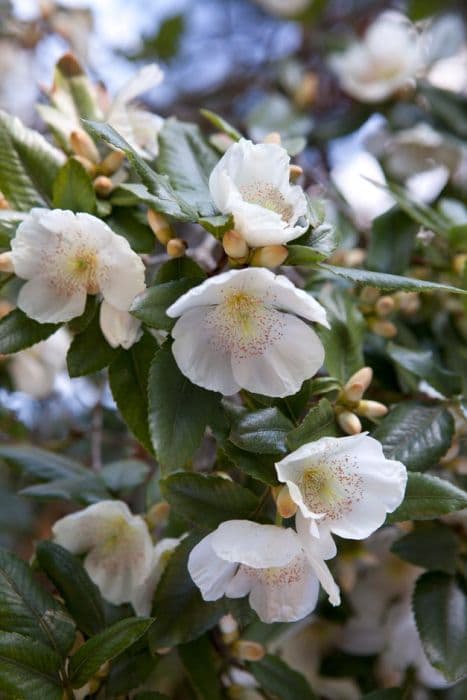Nymans Silver Eucryphia Eucryphia × nymansensis 'Nymans Silver' (v)

ABOUT
Eucryphia × nymansensis 'Nymans Silver', also commonly known as the 'Nymans Silver' eucryphia, is a captivating plant recognized for its ornamental features. The 'Nymans Silver' eucryphia showcases glossy, dark green leaves that offer a lush backdrop for its floral display. The foliage may also have a unique, silvery underside, which is where this cultivar gets its name 'Nymans Silver'. Contrasting beautifully against the foliage are the plant's exquisite flowers. These blossoms are typically large and cup-shaped, with a creamy white hue and a delicate, frilly appearance. At the center of each flower, a group of prominent stamens is visible, often adding a golden-yellow highlight to the overall floral presentation. The flowers are known for their delightful fragrance, which can attract a variety of pollinators, including bees and butterflies, to the garden. The overall form of the 'Nymans Silver' eucryphia is typically upright with a well-branched structure, creating an elegant and tidy appearance in the landscape. The bark is usually smooth and can add to the visual interest of the plant, particularly during the winter months when the leaves may have fallen, revealing the framework of the branches beneath.
About this plant
 Names
NamesSynonyms
Nymans Silver Eucryphia, Nymans Eucryphia.
Common names
Eucryphia × nymansensis 'Nymans Silver' (v).
 Toxicity
ToxicityTo humans
The plant known as Nymans Silver does not have significant toxicity reported for humans. While it's always best to avoid ingesting plants that aren't known to be edible, there are no well-documented cases or reports indicating that this particular hybrid eucryphia causes poisoning in humans. Therefore, accidental ingestion of Nymans Silver is unlikely to cause harm, but it's recommended to exercise caution and keep an eye out for any adverse reactions if ingestion occurs, particularly in individuals with plant sensitivities or allergies.
To pets
Nymans Silver is not known to be toxic to pets. There is no widespread information or specific reports on the toxicity of this eucryphia hybrid for dogs, cats, or other household animals. As with humans, it is generally advisable to prevent pets from ingesting plants that are not intended for consumption, but accidental ingestion of Nymans Silver is not expected to result in poisoning or serious health issues for pets. Always monitor your pets and contact your veterinarian if you notice any unusual symptoms after ingestion.
 Characteristics
CharacteristicsLife cycle
Perennials
Foliage type
Evergreen
Color of leaves
Green
Flower color
White
Height
20 feet (6 meters)
Spread
10 feet (3 meters)
Plant type
Shrub
Hardiness zones
8
Native area
Australia Tasmania
Benefits
 General Benefits
General Benefits- Ornamental Appeal: Eucryphia × nymansensis 'Nymans Silver' (Nyman's Eucryphia) has attractive silver-variegated leaves and large, white flowers that provide visual interest in gardens and landscapes.
- Wildlife Attraction: The flowers produce nectar which can attract bees, butterflies, and other pollinating insects, supporting local biodiversity.
- Shade Provider: As a tree, Nyman's Eucryphia can offer shade in gardens or when planted along streets, reducing local temperature and providing shelter from the sun.
- Seasonal Interest: This plant offers seasonal interest with its changing leaf color in autumn and flowering period in late summer, thus contributing to year-round garden aesthetics.
- Drought Tolerance: Once established, Eucryphia × nymansensis 'Nymans Silver' can tolerate periods of drought, making it suitable for regions with water scarcity.
- Sound Barrier: As a dense, evergreen tree, it can act as a natural sound barrier, reducing noise pollution in urban and suburban areas.
- Privacy Screen: With its evergreen foliage, it can also provide privacy when planted as a hedge or screen.
 Medical Properties
Medical PropertiesThis plant is not used for medical purposes.
 Air-purifying Qualities
Air-purifying QualitiesThis plant is not specifically known for air purifying qualities.
 Other Uses
Other Uses- Eucryphia 'Nymans Silver' wood can be used in fine woodworking projects due to its fine grain and texture, making it suitable for crafting small objects like boxes or inlays.
- The flowers can be a source of nectar for bees, contributing to the support of local bee populations and the wider ecosystem.
- Due to its dense and evergreen foliage, Eucryphia 'Nymans Silver' can be utilized as a privacy screen in gardens and parks.
- The plant's resistant nature makes it a good choice for coastal areas where it can act as a windbreak to protect more sensitive plants.
- Its striking flowers make Eucryphia 'Nymans Silver' an excellent candidate for ornamental use in flower arrangements and bouquets.
- The plant can be grown as part of a mixed shrub border to add height and structure to landscaping designs.
- Its attractive foliage and overall form are ideal for creating a focal point in a garden, guiding the viewer’s eye through the landscape.
- The bark of Eucryphia 'Nymans Silver' possesses textural qualities that can be used in garden design to add contrast against smoother-leaved plants.
- When planted en masse, the trees can create a microclimate within a garden, moderating temperature and humidity levels.
- Eucryphia 'Nymans Silver' can serve a role in educational gardens or arboreta, used to educate the public about different plant species and their ecological roles.
Interesting Facts
 Feng Shui
Feng ShuiThe Eucryphia is not used in Feng Shui practice.
 Zodiac Sign Compitability
Zodiac Sign CompitabilityThe Eucryphia is not used in astrology practice.
 Plant Symbolism
Plant Symbolism- Resilience: Eucryphia × nymansensis 'Nymans Silver,' commonly known as Eucryphia, is known for its robust nature and ability to thrive in different conditions, much like resilience in the face of adversity.
- Endurance: The eucryphia plant's hardiness and long-lasting blooms symbolize enduring qualities in life and relationships.
- Purity: The white and pristine flowers of Eucryphia are often associated with purity, innocence, and cleanliness.
- Beauty: With its attractive silver-edged leaves and striking flowers, Eucryphia represents beauty and the appreciation of aesthetics.
 Water
WaterThe Tasmanian Leatherwood, or Eucryphia × nymansensis 'Nymans Silver', prefers consistent moisture and should be watered deeply once a week with about 1.5 gallons per watering for an established shrub. During hot or dry periods, increase watering frequency to twice a week, ensuring that the water penetrates deeply into the soil to reach the roots. Avoid letting the soil dry out completely, but also be careful not to overwater as this can lead to root rot. Always check the top inch of soil for dryness before watering again.
 Light
LightThe Tasmanian Leatherwood thrives best in full sun to partial shade conditions. It is ideal to provide it with a spot that receives several hours of direct sunlight in the morning, followed by partial shade during the hottest part of the day to prevent scorching the leaves. Adequate light is crucial for flowering and overall plant health.
 Temperature
TemperatureFor the Tasmanian Leatherwood, ideally maintain temperatures between 50°F and 70°F, which promote healthy growth. It can tolerate minimum temperatures down to about 20°F and maximum temperatures up to about 85°F, but extended periods outside of the ideal range can stress the plant. Protect it from frost and extreme heat to prevent damage.
 Pruning
PruningPruning the Tasmanian Leatherwood is best done in late winter or early spring before new growth begins. Pruning is used to shape the plant, remove any dead or diseased branches, and promote healthier growth. It is not necessary to prune annually, but if size control or shaping is desired, ensure it's done sparingly to avoid excessive stress on the plant. The best time for pruning to maintain flowering is immediately after the blooms have faded.
 Cleaning
CleaningAs needed
 Soil
SoilThe Nymansay requires acidic soil with a pH range of 5.0 to 6.5. A well-draining mix rich in organic matter provides the best conditions. Incorporate peat moss, leaf mold, and pine bark to increase acidity and improve soil structure.
 Repotting
RepottingThe Nymansay, being a hybrid of Eucryphia, typically doesn't require frequent repotting. It should be repotted every 2 to 3 years or when it has outgrown its current container to prevent root-bound conditions.
 Humidity & Misting
Humidity & MistingThe Nymansay prefers moderate to high humidity levels, ideally around 50-60%. Avoid placing it in overly dry conditions, which can cause stress to the plant.
 Suitable locations
Suitable locationsIndoor
Provide bright, indirect light and maintain humidity.
Outdoor
Plant in acidic soil, partial shade, shelter from strong winds.
Hardiness zone
7-9 USDA
 Life cycle
Life cycleEucryphia × nymansensis 'Nymans Silver', commonly known as Nymans Silver Eucryphia, begins its life as a seed, which germinates in moist, well-drained soil in late winter or early spring. The seedling stage follows, where the plant develops its initial root system and first set of true leaves. As it enters the vegetative stage, the Eucryphia × nymansensis 'Nymans Silver' grows rapidly, forming a bushy shrub with silver-tinted, evergreen foliage. The plant reaches maturity in several years, flowering in late summer to early autumn with white, sometimes slightly pink-tinted blooms that attract pollinators. After pollination, it produces seed capsules that, once ripened, release seeds to begin a new generation. The shrub continues this cycle for many years, and with appropriate care, can live several decades.
 Propogation
PropogationPropogation time
Early Spring
Eucryphia × nymansensis 'Nymans Silver', commonly known as Nymans Silver Eucryphia, is typically propagated by semi-hardwood cuttings. The ideal time for taking cuttings is in late summer to early fall, when the new growth has begun to mature but is not yet fully hardened. A successful propagation method involves selecting healthy, non-flowering shoots of the current year's growth. These cuttings should be about 4 to 6 inches (10 to 15 centimeters) long and should be trimmed just below a leaf node. The lower leaves are then removed, and the cut end is dipped in rooting hormone to enhance the rooting process. The prepared cuttings are placed in a well-draining potting mix and kept under high humidity and consistent moisture until roots develop, which can take several weeks. It is crucial to protect the cuttings from direct sunlight and extreme temperatures during this period to ensure successful propagation.




